 History Jhansi City
History Jhansi City
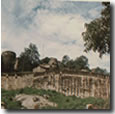 |
At that time
Lord Dalhousie was the Governor -General of India. Though
little Damodar Rao, adopted son of late Maharaja Gangadhar
Rao and Rani Laxmi Bai was Maharaja's heir and successor
as per the Hindu tradition, but the British rulers rejected
Rani's claim that Damodar Rao was their legal heir.Lord
Dalhousie decided to annexe the state of Jhansi asMaharaja
Gangadhar Rao had left no legal heir. This misfortune
of Jhansi was used by the Britishers to expand their Empire.In
March 1854 the British ruler announced 60,000 ( Sixty
Thousand) annual pension for Rani and also ordered to
leave the Jhansi fort. Jhansi was in humiliating condition
but it was like a silent volcano before eruption.Rani
Jhansi was determined not to give up Jhansi. |
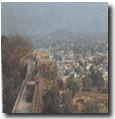 |
She was a symbol
of patriotism and self respect. Britishers were making
every effort to destroy the freedom of country where as
Rani was determined to get rid of Britishers.Rani Laxmi
Bai strengthened the defence of Jhansi and she assembled
a volunteer army of rebellions. Women were also given
Military training. Rani was accompanied by her brave warriors,
some of them were Gulam Gaus Khan, Dost Khan, Khuda Baksh,
Lala Bhau Bakshi, Moti Bai, Sunder-Mundar, Kashi Bai,
Deewan Raghunath singh and Deewan Jawahar Singh. Along
with all these warriors the local population of Jhansi
irrespective of their religion or caste were always determined
to fight and give their lives with pleasure for the cause
of Independence and their beloved Rani.The Britishers
attacked Jhansi in March 1858. Rani Jhansi with her faithful
warriors decided not to surrender. |
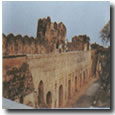 |
The fighting
continued for about two weeks. Shelling on Jhansi was
very fierce. In the Jhansi army women were also carrying
ammunition and were supplying food to the soldiers. Rani
Laxmi Bai was very active.She herself was inspecting the
defence of the city.However, after this great war, Jhansi
fell to the British forces. On that black day, the British
army entered the Jhansi City. Rani Laxmi Bai, still full
of courage and patriotism dressed as a man, took up arms,
her son Damodar Rao was strapped tightly to her back.She
was holding the reins of her horse in her mouth. In the
fierce fighting she was using the sword with both her
hands. When the situation was not in control, Rani of
Jhansi with some of her warriors departed from Jhansi.
Rani Laxmi Bai reached Kalpi. Many other rebellions force
joined her. |
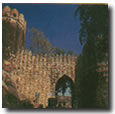 |
Tattia
Tope from Kalpi was also one of them, from Kalpi Rani
departed to the Gwalior. Again a fierce battle took place.
Rani Jhansi fought with deathless patriotism and martyrdom.
However on the second day of fighting, the great heroine
of the first struggle for India freedom, at the age of
22 years, lost her life. That unfortunate day was 18th
June of 1858.The fort of Maharani Jhansi has strategic
importance since the earliest of times. It was built by
Raja Bir Singh Ju Deo (1606-27) of Orchha on a rocky hill
called Bangra in the town of Balwantnagar (presently known
as Jhansi). The fort has ten gates ( Darwaza) .Some of
these are Khandero Gate, Datia Darwaza, Unnao gate, Jharna
Gate, Laxmi Gate, Sagar Gate, Orchha Gate, Sainyar Gate,
Chand gate. Among places of interest within the main fort
area are the Karak Bijli Toup ( Tank), |
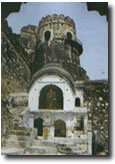 |
Rani Jhansi Garden, Shiv temple and a "Mazar"
of Ghulam Gaus Khan, Moti Bai and Khuda Baksh .The Jhansi
fort, a living testimony of ancient glamor and valour,
also has a fine collection of sculptures which provide
an excellent inside into the eventful history of Bundelkhand.Ganesh
Mandir, where the marriage ceremany of Maharani Laxmi
Bai, the brave heroine of 1857 Inedependence war, and
Maharajai Gangadhar Rao was performed. This temple is
dedicated to Lord Ganesh.located on the northern slop
of the fort, it is built near the main entrance (city
gate). dedicated to Lord Ganesh, This temple is executed
in the traditional Maratha style. The temple was very
popular until the fort was taken over by the British.
Rani Laxmi Bai paid regular visits to this temple for
worship. Entered through an arched entrance, it comprises
a courtyard, Mandapa an Garbhagriha,
ceiling of the latter being decorated with various geometrical
and floral patterns. |
| ..Back |
|
|
|